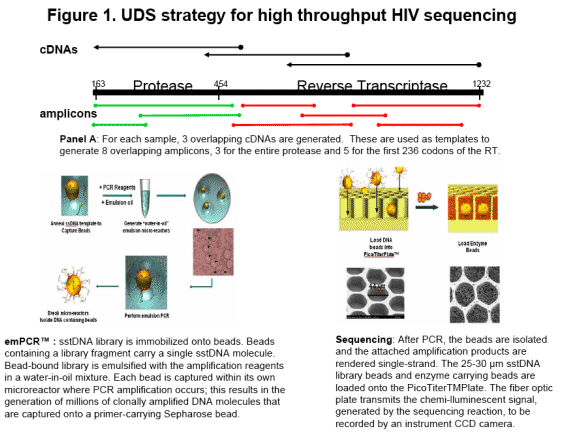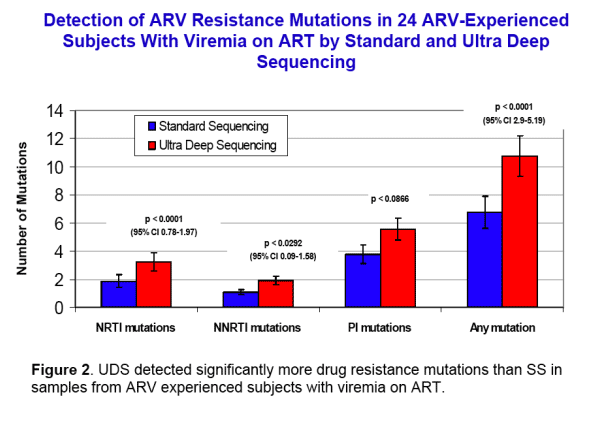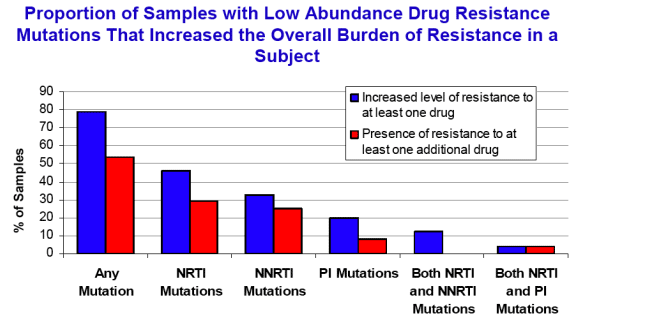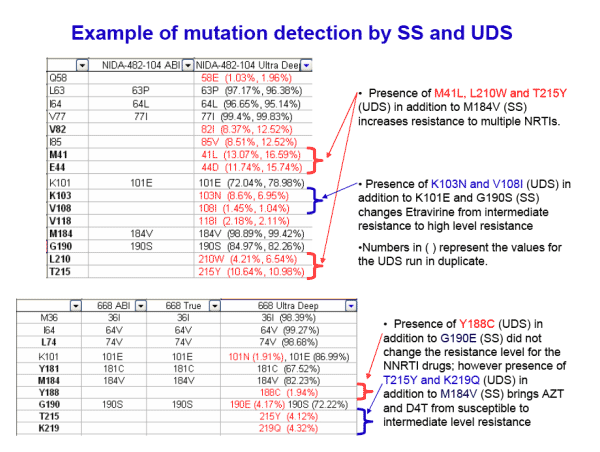 |
 |
 |
| |
Detection of Low Abundance Drug Resistant HIV Variants in Treatment Experienced Subjects by Ultra Deep Sequencing (454 Life Sciences/Roche Test)
|
| |
| |
T Le1, J Chiarella1, BB Simen2, B Hanczaruk2, M Egholm2, ML Landry1, K Dieckhaus3and MJ Kozal1,4
1. Yale School of Medicine 2. 454 Life Sciences/Roche 3. University of Connecticut 4. VA Connecticut Healthcare System, New Haven, CT, USA. Contact info: Thuy.Le@yale.edu
AUTHOR Conclusions
Low abundance drug resistance HIV mutations as detected by UDS in ARV-experienced patients with viremia on ART are common and often not detected by current standard Sanger sequencing methods.
The overall burden of resistance [by increased level of resistance to an ARV(s) and/or by presence of resistance to an additional ARV(s)] in an ARV-experienced individual is greater than that reflected in standard genotypes.
How the on-going viral replication from these low abundance drug resistant populations affects the viral dynamic and ARV treatment outcomes in a patient on therapy remains to be elucidated.
Future Directions
Perform further analyses of the relationship between subjects'ARV treatment history, adherence and outcomes with UDS resistance profile.
Develop a prospective longitudinal cohort study to investigate:
-- the viral evolution of low abundance ARV resistant variants during ART
-- relationship with treatment outcome
Acknowledgements
NIH T32 training grant (TL)
VA Merit and CDA funding (MJK)
454 Life Science/Roche for providing Ultra Deep sequencing support free of charge
Background
Low abundance drug resistant HIV variants at levels as low as < 1% of the viral quasispecies can be detected in antiretroviral(ARV)-naive individuals by sensitive and quantitative genotyping technologies. These variants have been shown to impact clinical responses in individuals initiating antiretroviral therapy (ART).1-5
What is less defined is how often resistant variants go unrecognized by standard sequencing methods in ARV experienced individuals with detectable viral loads on ART, and if these unrecognized variants increase the overall burden of resistance in an infected individual.
1. Johnson JA, et al. Antiviral Therapy 2006;11:S79.
2. Miller M,et al Antiviral Therapy 2006;11: S78.
3. Palmer S, et al. AIDS 2006: Volume 20(5) 21p 701-710
4. Huppler Hullsiek K, CROI 2008 abs 878
5. Simen B, et al XVI Intl HIV drug resistance workshop 2007 abs134.
Objectives
Determine the prevalence and profile of low abundance drug resistance HIV mutations in ARV-experienced subjects with viremia on ART using Ultra Deep sequencing (UDS) technology.
Compare the prevalence of drug resistance mutations in ARV-experienced subjects with viremia on ART as detected by standard Sanger based sequencing (SS) and UDS.
Methods
24 plasma samples from ARV-experienced subjects who had viral load ≥1000 c/mLwhile on ART were evaluated.
SS and UDS of HIV Protease and Reverse Transcriptase genes were performed to detect ARV resistance mutations (defined by the IAS-USA 2007 and Stanford HIV drug resistance database 2007).
UDS methods are illustrated in figure 1.
Descriptive statistics were used to describe the prevalence and profile of low abundance ARV resistance mutations.
Paired Student T test was used to compare the mean number of drug resistance mutations detected by SS vs. UDS with calculated p values and 95% confidence intervals.

Results
UDS detected significantly more drug resistance mutations than SS in samples from ARV experienced subjects with viremiaon ART (Figure 2).
the 24 samples from ARV-experienced subjects (viral load range: 1,380 to 500,000 c/mL) low abundance drug resistance mutations at levels 0.8% to <20% were identified in all 24 samples by UDS and were not detected in 88% (21/24) samples by SS.
The number of low abundance resistance mutations detected by UDS ranged from 1-10 per sample (mean of 4).
Low abundance drug resistance mutations account for 38% (99/259) of all mutations detected by UDS; of these mutations, 62% (61/99) were detected at level 0.8 to 5% (Figure 3).


Results (cont)
Of the additional low abundance drug resistance mutations identified in 24 samples by UDS, 79% (19/24) of samples harbored low abundance PI mutations (the majority being "minor IAS-USA"PI mutations); 75% (18/24) had low abundance NRTI mutations; 50% (12/24) had low abundance NNRTI mutations -[of these, 67% (8/12) had either a K103N, Y181C, Y188C or G190E].
Of the additional low abundance drug resistance mutations identified in 24 samples, 37.5% (9/24) harbored additional mutations which imparted resistance to a single class of ARV, 25% (6/24) to 2 classes, and 37.5% (9/24) to 3 classes (Figure 4).
The proportion of samples with low abundance drug resistance mutations that harbored greater overall resistance by increased level of resistance to at least one ARV(s) were 79% (19/24) and by presence of resistance to at least one additional ARV(s) were 13/24 (54%) (Figure 5).


|
| |
|
 |
 |
|
|